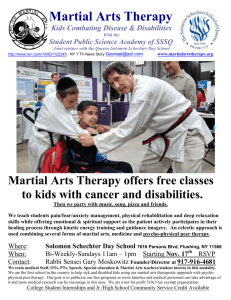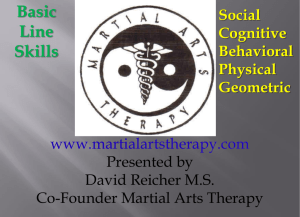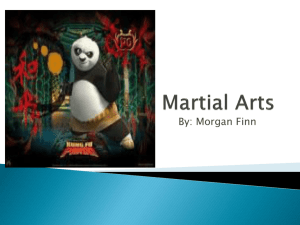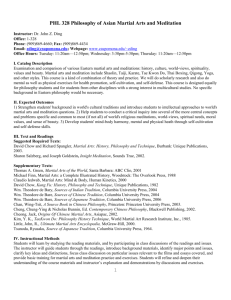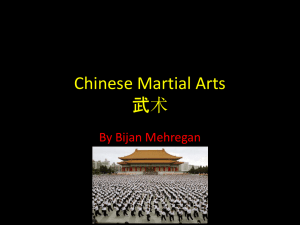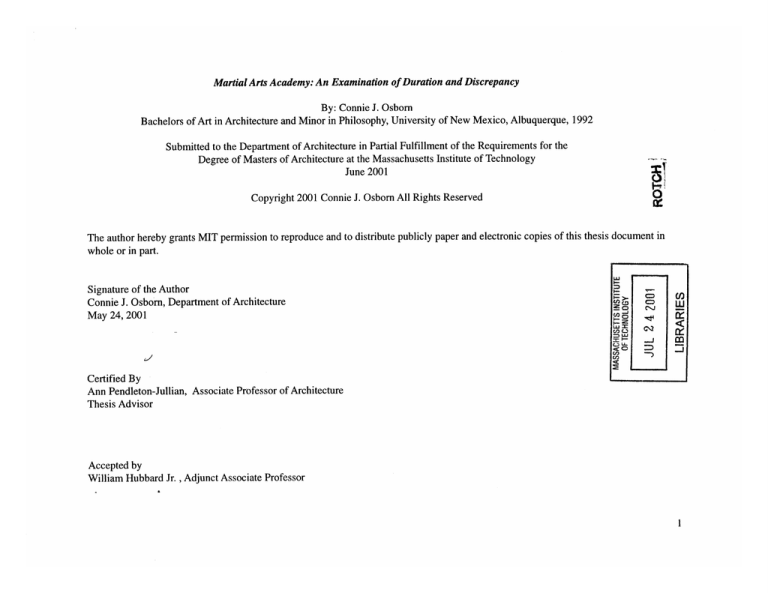
Martial Arts Academy: An Examination of Duration and Discrepancy
By: Connie J. Osborn
Bachelors of Art in Architecture and Minor in Philosophy, University of New Mexico, Albuquerque, 1992
Submitted to the Department of Architecture in Partial Fulfillment of the Requirements for the
Degree of Masters of Architecture at the Massachusetts Institute of Technology
June 2001
0
Copyright 2001 Connie J. Osborn All Rights Reserved
The author hereby grants MIT permission to reproduce and to distribute publicly paper and electronic copies of this thesis document in
whole or in part.
Signature of the Author
Connie J. Osborn, Department of Architecture
May 24, 2001
-
WoU
LlU
C,,
0,
Certified By
Ann Pendleton-Jullian, Associate Professor of Architecture
Thesis Advisor
Accepted by
William Hubbard Jr. , Adjunct Associate Professor
<C
~
2
Reader
Julia Scher, Lecturer in Visual Arts
MartialArts Academy: An Examinationof Durationand Discrepancy
By: Connie J. Osborn
Submitted to the Department of Architecture on May 24, 2001 in Partial Fulfillment of the Requirements for the
Degree for Masters of Architecture.
Abstract:
Other than the martial component, the primary concern for many of the martial arts is answering the question, "what is self?". The task of answering that
question has historically belonged to the martial arts to the extent that they both came out of Buddhist schools of thought. For many of the martial arts selfknowledge is one of the principle components.
Both Buddhism and Taoism talk about a 'way' of the world, which is also the 'way' of self. Self is the same for everyone as all beings are cut from the same
cloth of self. When one asks the question "what is self?", it is quite surpising to hear that self has no inherent features. We have all heard the Buddhist claim
that 'all is void', and will probably be more surprised to discover that this means that there is in fact no self at all.
The significance of this is revealed when one experiences that the nature of all things is change. This is why there are no features to self, as soon as one
defines self, that limited definition falls away and is replaced by a new one. The discovery of this is not as efacing as it may seem, as it offers in exchange for
a fixed self, one that can accomodate all things. It is void that permits the presence of things. According to Buddhist thought, all suffering arises from the
desire to have things remain the same. Accepting that they won't or can't liberates the self to the enjoyment of being in present time. The immediacy and
inherent meaning in all things becomes infinitely available. Within change it is evident that all things are continusous, without distinction one from the other.
In every sense, self belongs to the greater body of all existence.
In martial arts the practice of meditation is essential. The first lesson of meditation is often to simply observe ones breath. In the observation of the full
duration of breathing, the constancy of change becomes appearant and the experiencing of the exclusive truth of now is layed bare. In the performance
of martial arts this is vital. As soon as the artists mind stops or fixes in a particular moment, fear may enter, or she may rely on thought rather than being
to perform and thus lose the fluidity of free action and become victim to defeat.
If in the design of a martial arts academy it was the intention of the architecture to provide evidence of change, it would not be necessary to create change
because change is happening at all times and in all places. It may only be necessary to call attention to it.
In tracing the lines of overflow of the Rio-Grande River for the course of forty recorded years, I reaffirmed the truth of change. While examining the
discrepancy between and among each line I could not find the defining line of the river. I wanted to build this into the architecture, and so this became my
thesis.
Thesis Advisor: Ann Pendleton-Jullian
Title: Associate Professor of Architecture
Contents
Introduction ................
p. 5
..
The Site ....................
.
p. 6
M artial Arts ..................
p. 10
Design Process (translations) ......
p. 13
Landscape ................
p. 14
.
Time .....................
p.
Body (Teageuk Pal Jang) ....
p. 27
Results ...................
Bibliography ................
...
2 5
p. 32
..
p. 44
Introducion
Temporality
1
69 We move among things, portray them, represent them. By portraying and representing them we touch them and are yet separated from them. This
connecting being-separated is shown not only in the spatiality of our world, in the possibility of portrayal and of language, but also in temporality.
The dimension in which we touch things is in itself stretched out: distance to things and distance itself as temporality.
Wittgenstein
I knew from the begining that In choosing to design a Martial Arts Academy that what I wanted to look at was how to demonstrate change. The task
of portraying change was chosen over the more impossible task of uncovering the nature of self. The Bodhidharma defined self-nature as "that which
is of itself so. Self-nature has no appeance. Its body is no body. It's not some sort of ego, and it's not some sort of substrate or characteristic that exists
in or apart from phenomena. Self-nature is empty of all characteristics, including emptiness, and yet it defines reality." Red Pine
In the begining of any martial arts triaining meditation is introduced as an integral part of the study of the art. Meditation in this case is not just the type
that occurs while sitting on a pillow, but a kind that happens in pure action. The irony of the first method of meditation, observing one's breath, is that
it's goal, Nirvana, is translated as 'absence of breath'. It's aim is to point to change. Change is what keeps us from Nirvana, but in observing change
one may discover that all we take for real in our life is changing and therefore illusory or delusion. What is real is what is of itself so. The true nature
of self is not changing because it is nothing, it has no history and no future, it is out of the loop of time.
What I've chosen to point to is the opposite of what a martial arts training is intended to achieve. This is not without prescendence though, as it has
been a long part of Buddhist history to push oneself to the opposite extreme in an effort to achieve sudden awakening. Indian Yogi's, for example,
would put themselves in the middle of a ring of fire and sit in the desert for hours hoping for enlightenment.
I don't how it is possible to make something change more than the change that is the universal condition of things already. In other words, I don't
know how to make change stand out against change. So I've chosen to re-translate something that has been the symbol of change throughout man's
history, a river. The river is also a symbol of self-nature for Buddhists because it is something that constantly undergoes change, yet retains itself. And
Bruce Lee, the legendary martial artisit was known for saying, "Be like water !".
The Site
Bosque del Apache
6
Bosque del Apache
(Forestof the Apache)
Bosque del Apache is a 57,000 acre strip along the Rio Grande River located in the south-central region of
New Mexico in the Chihuahuan desert. The heart is a 7,000 acrea area of flood plain where the waters of the
river are diverted to create extensive wetlands and farmlands. It was established in 1939 to provide wintering habitat for the migratory birds which were already native to the site. In the winter it is home to more than
50,000 snow geese and ducks, and over 17,000 greater sandhill cranes. There is also an occasional siting of
the endangered whopping crane. The site is a diverse habitat of wetland, grasslands and desert serving as
home for hundreds of species of wildlife including coyotes, deer, eagles and cottonwoood trees.
Water is managed to imitate the ebb and flow of the Rio Grande as it was before channelization and dams.
The ancient Rio Grande's overflow was a product of snowfall in the Rocky Mountains and Summer monsoons. Originally, the river flooded and replenished natural marshlands that occured along the river. The
river no longer floods or meanders today. Marsh management is rotated in a manner that assures an availability of varied habitats. Dry impounds are burmed and then reflooded allowing natural marsh plants to grow.
When mature conitions are achieved, the cycle is repeated.
Local farmers cooperate in management efforts by growing crops that feed wintering fowl and cranes. They
plant alfalfa and corn. They harvest the alfalfa and leave the corn. Other crops like wheat and clover are also
grown, and native plants likewise provide food.
Sandhill cranes in flight (Stills from Bosque del Apache Documentary)
The site has been inhabited for hundreds of years. More than 700 years ago, the Piro Indians took advantage
of its fertile soil, abundant plant life and animal life. These pueblo dwellers farmed, raised birds, and hunted
the wildlife. Piro indian remains include pueblo dwelling ruins, kiva's, and animal rock art or, petrogliphs.
Tour Route and Walking Trails.
The site accomodates over 100,000 visitors annually. Its most popular attraction is the daily morning and evening flights of geese and
cranes from late fall to early spring.
A 15-mile auto and walking tour route borders the wetland and
farm complex. Wildlife is accustomed to visitors and so may be
observed from close distances. The route is oriented along the northsouth axis and provides views in the morning and late afternoon as
the birds move from north to south respectively throughout the
day. Throughout the tour, observation platforms are placed where
visitors may watch for as long as they like, the cycles of the birds.
Visitors information flyer
Whooping crane
Morning geese flyout
Martial Arts Academy Location
The location of the Martial Arts Academy is as indicated in orange in the map above. It's proposed located is just outside the refuge on the east
side of the river. The existing 2-mile walking path would be extended along the over-flow channel and cross the river to the other side in seasons
when the river was low enough to walk across, or by boat when full.
"SelfNature. Svabhava. That which is of itself so. Self-nature depends on nothing, either causally, temporally, or spatially. Self-nature has no
appearance. Its body is no body. It's not some sort of ego, and it's not some sort of substrate or characteristic that exists in or apart from phenomena.
Self-nature is empty of all characteristics, including emptiness, and yet it defines reality.
See your nature. Whether called self-nature, buddha-nature,or dharam-nature,our nature is our real body. It's also your false body. Our real body
isn't subject to birth and death, appearance or disappearance, but our false body is in a state of constant change. Seeing our nature, our nature sees
itself, because delusion and awarenss aren't different." Red Pine
......
.....
- -
The martial arts have been used and practiced as for military purposes and as a way of life for thousands of years. It is believed that the first martial arts were
developed in China at about the same time that Buddhism was making its way into the country. It is commonly argued that they emerged out of a combination of ideas
and practices.
One of those ideas is based in the notion that by imitating the movement of animals a person may increase his or her bodily abilities, both in fighting and in overall
health and agility. Hua-Tuo, an acient Chinese medical doctor (approx 1700 years ago) emphazied both mental and physical training as a way of improving health. He
may have been the first to recommend that human beings imitate the movement and life cycles of animals. Cranes, snakes, tigers and bears were imitated in an effort
to re-establish original life abilities. These animals forms were over time systematized into specific fighting forms one of which became known as Shaolin Kung Fu
or the 5 Animal fighting forms. It is believed that most martial arts form derived from these forms. Observing the natural facility in which animals seem to fight. The
sharp spirit of the eagle became a way of life, the pounding and heavy swiping of tigers, and the attacking motions of the crane's beak were also imitated. What was
remarkable was the way animals within this also maintain consistent life patterns.
The idea that there is balance, Yin and Yang was one of the prevailing religions of China. In the same manner that an animal may be comprised of both fighting and
peaceful elements was developed as a means of advancing mental and physical abilities as well as natural meditation. This intersected with Buddhism quite easily
because the both ended up with an idea of self that was un-tainted by illusory thought. There was a favoring of an inherent self-nature that was unaffected by intellect
and desires. It was ostensibly life as lived by animals and as reflected in what is all around us.
The study of animals easily became an inquiry into human self-nature. The Buddhist would maintain that self is devoid of all charateristics or aspects, it is nothing.
Any attempt to define it is futile because there is in fact nothing that can be said about it. A discovery of the nature of self is in terms of martial arts supposed to provide
the artist with fluidity, an unwavering concentration and indomitable spirit. For the human being in general it is a promise of the end of all forms of suffering.
Accepting and moving in accord with one's true self-nature, un-filtered by the intellect or by desire is the ultimate aim of martial arts.
Most martial arts answer the question of 'why the violence?' by claiming that it is for self-defence, but in another sense, strength of body and strength of mind are also
both necessary components in achieving spiritual advancement.
4001 ,4
cranes in fall
a coyote kills a crane
Translations
landscape
time
body
13
landscape
Study of object in landscape -
ink on paper
12
I began by drawing a map of the site. The site I chose is rich with symbols of change. There is the migration of birds which is linked to the
changing seasons. Ther is the slow change of mountian form adapted by wind, water, and time and there is the flow and overflow of the river.
-
7
a~
-
-------
-
I
-------------
1-
I
-a--
-- - -- -- -
I
I
-------- _ -- ----------
Site~~~~~
~ ~~
of
mutpecagstknalc
the
-
miikn the
oftetuatr
~~
loato by~S
hsni
utotieteB
orhgahc.Test
nteevrnet
moeetaI'L
of
sef
fehnig
ata
hs
foron
edlAah
rsha
nml
oghsoyo
c wtotatn
idierfg.I'
oainpritthobevin
bevn
n
nmli
i
ihu
riua
stig
hyaearfeto
rns
n
K
L-o
I
-
--
-
a
I
I
I
I
I
6..
m
j
NJ I~
I
I
a
s1.as*11O
HW
&;-I
ans
nsesammaas
NE iiE i.aa
a
SEM
a
na
-"
...
a
:s
qeem
maae
WN
uarnarnw
NO:r
" V
E
jsa
-
:'Ma
sa
e am
.......
a
On
a
e.
-
m
04=nemmasa
n
-::;
=Nom
w-...-.
az
A~
:
=.
Maan*08=00
ya
~
a
§.
A..
CER~iEEIMIeta0:1
~
I
I
<a
04 al *A 11 #j Z-4e
W: bea
61 S'O
eamVI4
I
I
~
- -
--- - --
---
I.n.
N
.:--..a
The orthographic grid says nothing about the site. In order to use the grid one must understand its content. For example, knowing of another
coordinate from which or to which to measure one could guage distance and derive location. The site would remain if the grid moved.
17
Data
i'm ft
t~
-
____
-
-110
ft
-
/7NA
/-
-
~
ft
-9P
-A-----60
-~~~5
---
_.f
F
am.
ft
~
t
40 ft
~t
Using historical overflow and precipitation data I generated a chart that shows what the approximate natural overflow of the river should be
in feet from the shoreline for the 12 months of the year. Of course, this would not be the same year to year as even this cycle is constantly
changing.I
IL
IJG
. .. . . .
.... . -
- ..
- -- ---
An approximation of the pattern that would emerge from tracing the lines of maximum overflow every 4 years from 1950 to 1998.
19
.-..---........
I ._---..--. ,--...-..-.-_-...
...,,--.-...
.. _._,,.. .
,....-......
. ..................
, . . ... _._I_.,.__..._.._.._.._._........ .. . .
.
. .....
Using the overflow pattern created by tracing lines of maximum overflow from the years 1950
to 1998 I erected walls, each in the location of the overflow line it corresponds to.
It is situated so that flooding would reach different heights of the walls each month of the year,
resulting in an alternating pattern of ponding. In time, this would be a kind of phenomenological
mapping of the changes of the river according to season and year.
1
.-- .:,k.....
.......
..
..-.. ......
. !_ , - - ,-
....
.....
..
:,-__,.,
!-
-
-
I
-
.......
.. ..
...
...
"The absence of definitions in the transmission of the Dharma is the touchstone of Zen Buddhism. It doesn't necessarily mean without
words, rather, without restrictionsas to the mode of transmission. A gesture is as good as discourse." Red Pine
23
'.. .
..
. .. I
......
.........
Ihe resulting tran. ttion generates
own kind of landscape. The objects begin to suggest
..
manner in wnicn
. . .. .........
.....
ianascape mignt De nnaritea.
Time
25
Time and Action
These are two studies which attempt
to draw correspondece between the
activity of the martial artist and time
of day.
The first imagines a shape or architectural configuration that would relate to the activity of the user on an
hourly basis. The top begins with a
sheltered area for the hours associated with sleep. Moving out the
horizontal plane is manipulated to
suggest the nature of the activity
taking place at the given hour. The
part that dips down would be a bath,
the top a spot for meditation or
training.
I
inmmM~mm~isaI
Hu~m
iLm~
-
NUR
The one below is imagined to be below ground and takes into accound
how the heat and intense sunlight
of the desert might be mitigated.
4-
mmmi
A17-
I
I
I
The graphic chart is an attempt to
correlate time of day with speed of
activity. The top is a depiction of the
heart-rate of a typical martial artist
in good health. It begins to suggest
section and talks about speed being
a generator for form. Where speed
increases objects would form out of
a more 'flat-line' landscape.
26
"In Long Formsyour body should move like the rhythmicflow
of water on a river or like the rollingwaves of the ocean."
Master Chang San-Feng
Body
Image from T'ai Chi Classics, Master Chang San-Feng
Taegeuk Pal Jang
.-.
Planar translation
The Taegeuk Pal Jang is the highest of the Taegeuk forms in Tae Kwon Do. It represents um and earth. Yang or positive energy is like heaven and the
origin of all things. Um or earth is Yin or negative energy, the opposite of heaven, and the end of all things. Students who advance to the study of this
form are eligible for promotion to Black Belt.
First I constructed a planar translation (see diagram at top) of the directions, pivots, and turns of the 22 moves of the Taegeuk Pal Jang. Then I retranslated it into a 3D form spatially analagous to the movements of the form.
3D translation of Taegeuk Pal Jang
The translations of the river overflow mapping and the 3D translations of the Taegeuk Pal Jang are
translated again in a manner that suggests how the two might move together. The movement of the
landscape and the movement of the body merge.
30
..
,......
......
.. I.-,.-
Results
32
The walls in the site.
"Walls. After he arrived in China, Bodhidharma spent nine years in meditation facing the rock wall of a cave ... Bodhidharma's walls of emptiness connect all
opposites, including self and other, mortal and sage. " Red Pine
"Once you begin to move, the entire body must be light and limber. Each part of your body should be connected to every other part."
Master Chang San-feng (1200 C.E.)
...
........
....
Site and movement
The site is layed out in accordance with the walls as generated by the
overflow mapping. It would be approached begining from the road
bordering the refuge site at the end of the existing 2 mile walking
trail. Across the river and then along the crest of the slow sloping
site. The first wall is encountered as a barrier from a view of the site
below. Instead, ones view is fixed on a small crop of corn which
would be raised and kept for the feeding of the migrating birds. This
first gesture introduces the participant to the rhythms of change native to the site. First, the seasonal growing of crops as it relates to the
migration of birds. Secondly, the rythm of the rows of corn would act
as a registration of movement calling attention to the change by displacement in space of the users body. The path along the corn changes
angle and the rate of displacement of the rows increases as the view
into them widens.
Once around the wall a long and widening path prolongs entry into
the architecture. Inside, one winds one's way in with increasing turns
as one gets closer to the main training hall.
A juxtapositioning of the time studies with site plan and section begin to demonstrate the manner in which spaces become objects in the
landscape according to an increase in the speed of the activity associated with programmatic element. In the center where all activity
centers, around the main training and meditation hall, the architecture is most object like. The architecture forms a relationship with
the walls adjusting to them in some instances and transforming them
in others.
The residences on the otherhand, where activity is presumed lowest,
would reside strictly between the walls generated by mapping the
overflow of the river by seasons.
Living and training within the walls, river overflow would occasionally fill the lowest parts of the ground-plane, and the users would
over time observe the change of water overflow with the seasons,
growth of crops and migration of cranes.
ccm
nel
Lower Floor Plan
Can HM
Upper Floor Plan
AAPA*%-
MOM,
m "*4t
i
M Memo
Owwwww Or
-,
7-1
Site Section
I
W.
&ie
sukkaku.x.
s~
xssu~
.
..
..- ..........
--.
.....
....
......
.
duddde
sudendesmidddadded
suddenddendsdeindsudde
deleininddeinds:iddenddadado::ddaddaddaddwMaduoddu::audu:xxx:dwouuddaduedadduumouussusuuduouessoussou
Bibliography
44
Brand, Gerd
The Essential Wittgenstein
Basic Books, Inc., Great Britain, 1979.
Bercholz & Kohn
Entering the Stream an Introduction to Buddha and his teachings
Shambhala, Boston, 1993.
Bones, Jim
Rio Grande, Mountains to the Sea
Texas Monthly Press, Austin Texas, 1985.
Broughton, Jeffrey L.
The Bodhidharma Anthology, The earliest recordings of Zen
University of California Press, Berkeley, LA, London, 1999.
Liao, Waysun
T'ai Chi Classics
Shambhala, Boston & London, 1990.
Muybridge, Eadweard
The Male and Female Figure in Motion
Dover Publications, Inc., New Yorkl984
Pine, Red
The Zen Teaching of Bodhidharma
North Point Press, New York, 1987.
Suzuki, D. T.
Zen Buddhism, Seleted Writings of D.T. Suzuki
Image Books, Doubleday, New York, 1956
Suzuki, D.T.
The Zen Doctrine of No-Mind
Samuel Wieser, Inc., York Beach, Maine, 1991.
Whang, Sung Chul
Taekwondo. The State of the Art
Broadway Books, New York, 1999.
Nature Documentary.
Leading Object*
Southwest Horizon Nature Series, Bosque del Apache, Ancient Flyway of the Rio Grande
New Mexico State University, College of Agriculture and Economics, New Mexico, 2000.
http://www.rozylowicz.com/retirement/bosquedelapache/bosqueapache.htm
http://southwest.fws.gov/refuges/newmex/bosque.html
* all images of birds and wildlife are stills taken from Bosque Del Apache Nature Documentary. All other images are by the author or as indicated.
46


